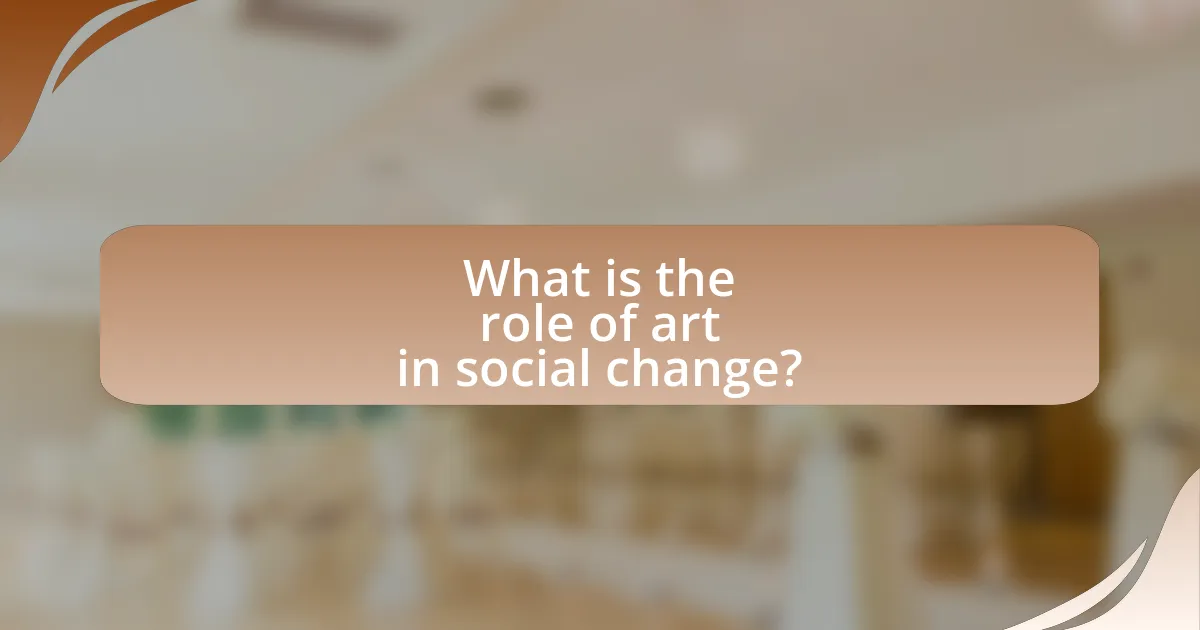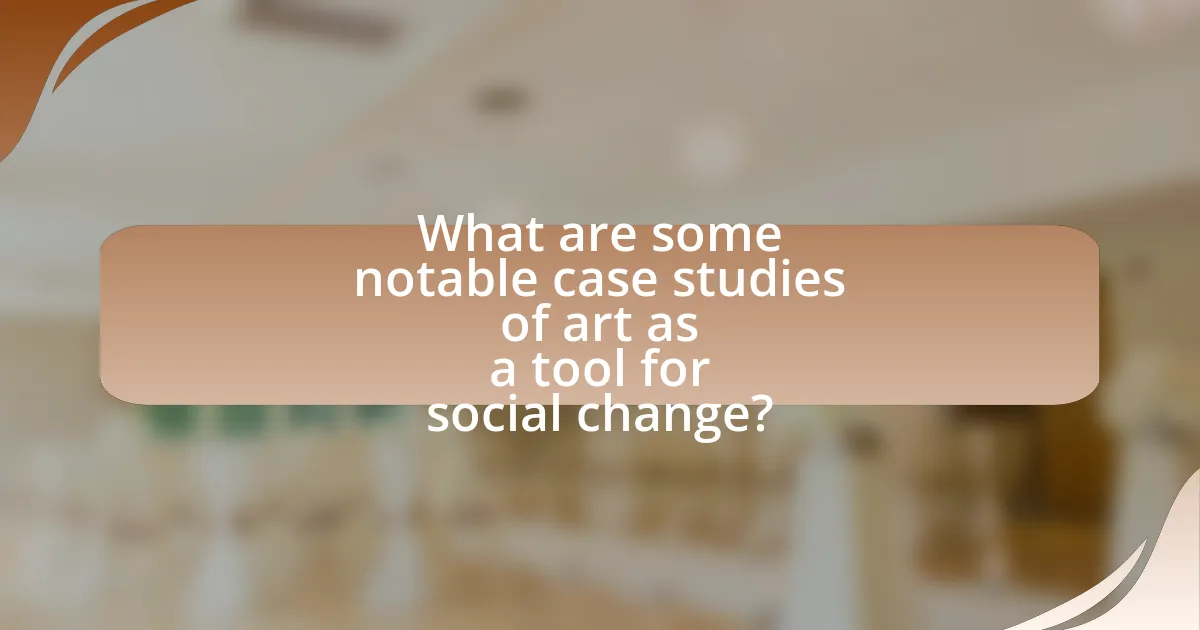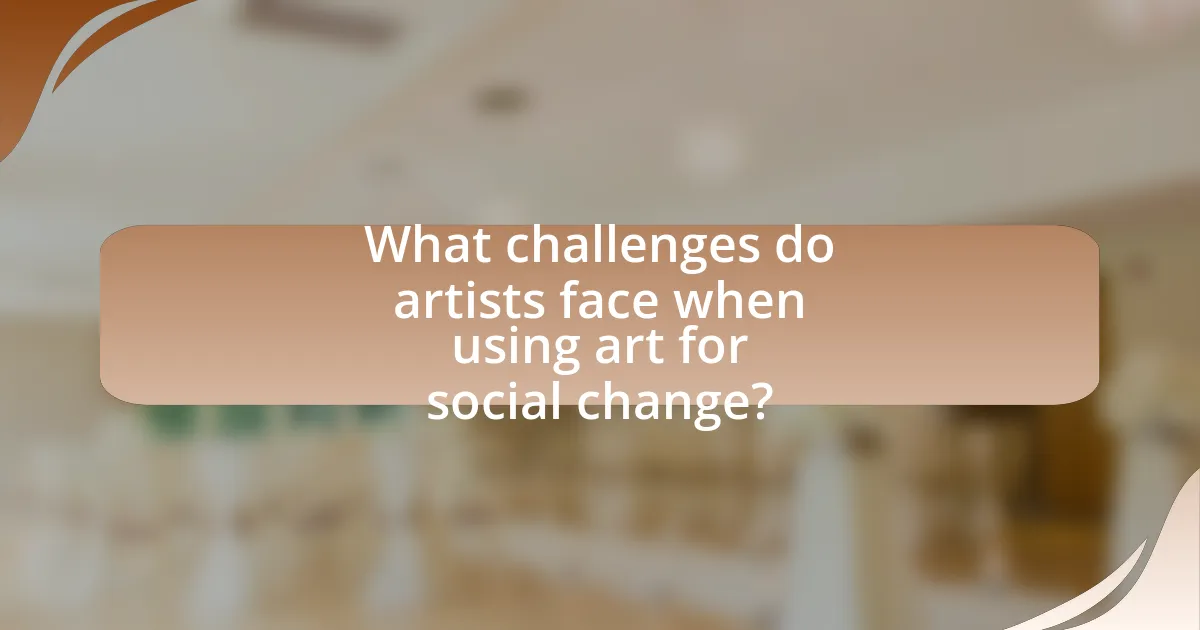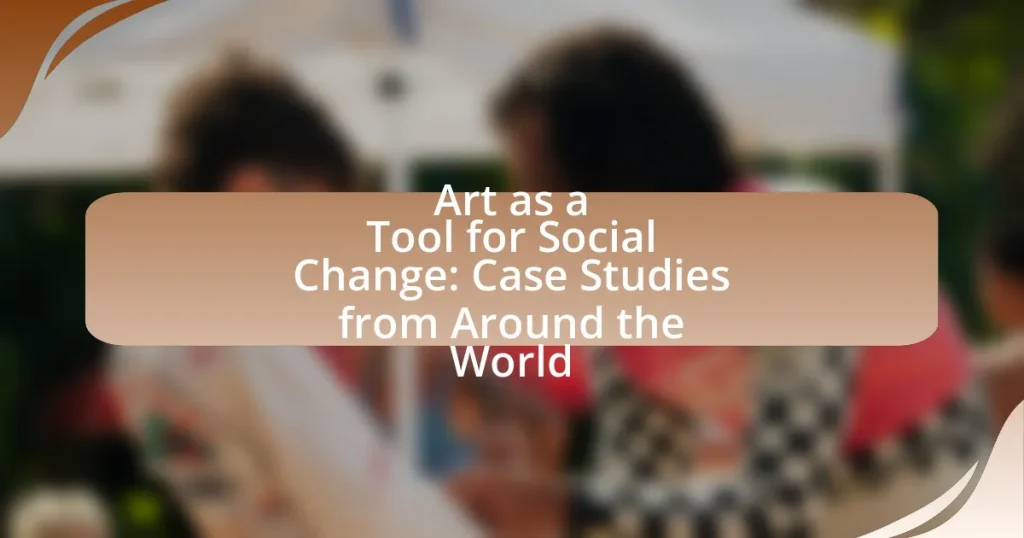The article examines the role of art as a powerful tool for social change, highlighting its capacity to express, raise awareness, and mobilize communities around critical issues such as inequality, injustice, and human rights. It provides historical examples, including the Civil Rights Movement and the Arab Spring, showcasing how various forms of art—such as protest songs, murals, and performance art—have influenced social movements globally. The discussion also addresses the psychological effects of art on individuals and communities, the challenges artists face, and the strategies they can employ to maximize their impact, emphasizing the importance of collaboration and technology in amplifying artistic messages for social advocacy.

What is the role of art in social change?
Art plays a crucial role in social change by serving as a medium for expression, awareness, and mobilization. It has the power to challenge societal norms, provoke thought, and inspire action, often addressing issues such as inequality, injustice, and human rights. Historical examples include the use of protest songs during the Civil Rights Movement in the United States, which galvanized public support and raised awareness about racial discrimination. Additionally, visual art, such as murals and installations, has been employed in various movements worldwide to communicate messages and foster community engagement, as seen in the street art of the Arab Spring that highlighted calls for democracy and reform. These instances demonstrate that art not only reflects societal issues but also actively participates in the dialogue and actions that drive social change.
How has art historically influenced social movements?
Art has historically influenced social movements by serving as a powerful medium for expression, mobilization, and awareness. For instance, during the Civil Rights Movement in the United States, artists like Jacob Lawrence and musicians such as Nina Simone used their work to highlight racial injustices and inspire activism. Similarly, the Mexican muralists, including Diego Rivera, utilized public murals to communicate social and political messages, galvanizing support for the Mexican Revolution. These examples illustrate how art not only reflects societal issues but also actively shapes public discourse and encourages collective action, thereby reinforcing its role as a catalyst for social change.
What are some key examples of art impacting social change in history?
Key examples of art impacting social change in history include Picasso’s “Guernica,” which protested the horrors of war and influenced anti-war movements, and the “AIDS Memorial Quilt,” which raised awareness about the AIDS crisis and advocated for LGBTQ+ rights. “Guernica,” created in response to the bombing of a Spanish town during the Spanish Civil War in 1937, became a powerful symbol of the tragedies of war and has been used in various protests against violence. The “AIDS Memorial Quilt,” initiated in 1987, consists of panels commemorating individuals lost to AIDS, effectively humanizing the epidemic and mobilizing public support for research and treatment. These artworks demonstrate how visual expression can galvanize public sentiment and drive social change.
How do different cultures utilize art for social advocacy?
Different cultures utilize art for social advocacy by employing various artistic forms to address social issues and promote change. For instance, in the United States, street art and graffiti have been used to highlight racial injustice and police brutality, as seen in the works of artists like Banksy and local muralists during the Black Lives Matter movement. In Brazil, the Carnival serves as a platform for political expression, where samba schools create elaborate parades that critique social inequalities and celebrate cultural identity. Additionally, Indigenous communities worldwide use traditional art forms, such as weaving and carving, to advocate for land rights and environmental protection, exemplified by the Maori in New Zealand who incorporate their cultural narratives into contemporary art to raise awareness about climate change. These examples illustrate how art transcends cultural boundaries, serving as a powerful medium for social advocacy across diverse societies.
Why is art considered a powerful tool for social change?
Art is considered a powerful tool for social change because it effectively communicates complex ideas and emotions, fostering empathy and awareness among diverse audiences. Through various forms such as visual art, music, and performance, artists can challenge societal norms, provoke thought, and inspire action. Historical examples include the role of protest songs during the Civil Rights Movement in the United States, which galvanized public support for racial equality, and the use of street art in the Arab Spring, which visually articulated the demands for freedom and democracy. These instances demonstrate how art can mobilize communities, influence public opinion, and ultimately drive social transformation.
What psychological effects does art have on individuals and communities?
Art has significant psychological effects on individuals and communities, fostering emotional expression, social cohesion, and mental well-being. For individuals, engaging with art can lead to improved mood, reduced anxiety, and enhanced self-esteem, as evidenced by studies showing that art therapy can alleviate symptoms of depression and PTSD. For communities, art serves as a catalyst for social change, promoting collective identity and solidarity, which is supported by research indicating that community art projects can strengthen social ties and reduce feelings of isolation. Furthermore, public art initiatives have been linked to increased community pride and engagement, demonstrating that art not only enriches individual lives but also enhances the social fabric of communities.
How does art foster dialogue and awareness around social issues?
Art fosters dialogue and awareness around social issues by serving as a medium for expression that transcends language and cultural barriers. Through visual arts, performances, and literature, artists can highlight injustices, provoke thought, and inspire action. For instance, the mural movement in the United States during the civil rights era utilized public spaces to communicate messages of equality and resistance, effectively engaging communities in discussions about race and justice. Additionally, studies have shown that participatory art projects, such as those documented in “Art for Social Change: A Global Perspective” by authors like Claire Bishop, demonstrate how collaborative art initiatives can mobilize communities and raise awareness about pressing social issues, thereby fostering a collective dialogue.

What are some notable case studies of art as a tool for social change?
Notable case studies of art as a tool for social change include the “AIDS Memorial Quilt,” which raised awareness about the AIDS epidemic and honored those who died from the disease, leading to increased funding and support for HIV/AIDS research and treatment. Another significant example is the “Street Art Movement” in Egypt during the Arab Spring, where graffiti artists used public spaces to express dissent against the government, mobilizing citizens and fostering a sense of community and resistance. Additionally, the “One Million Bones” project involved artists and activists creating clay bones to raise awareness about genocide and mass atrocities, successfully engaging communities and influencing policy discussions on human rights. These case studies illustrate how art can effectively drive social change by raising awareness, fostering community engagement, and influencing public policy.
How has street art contributed to social movements globally?
Street art has significantly contributed to social movements globally by serving as a powerful medium for political expression and community engagement. For instance, during the Arab Spring, street art became a vital tool for activists in countries like Egypt, where murals and graffiti conveyed messages of resistance against oppressive regimes, fostering a sense of solidarity among protesters. Additionally, in the United States, street art has played a crucial role in movements such as Black Lives Matter, with artists using public spaces to highlight issues of racial injustice and police brutality, thereby raising awareness and mobilizing support. The impact of street art is further evidenced by the global proliferation of murals that address social issues, such as climate change and gender equality, demonstrating its effectiveness in inspiring dialogue and action within communities.
What are specific examples of street art that have sparked change?
Specific examples of street art that have sparked change include the “Girl with a Balloon” by Banksy, which has become a symbol of hope and political activism, particularly during the Brexit debate in the UK. Another example is the “Fearless Girl” statue, which was installed facing the “Charging Bull” on Wall Street, promoting gender equality and women’s empowerment. Additionally, the murals created during the Black Lives Matter movement, such as the “Black Lives Matter” mural in Washington, D.C., have played a significant role in raising awareness about racial injustice and police brutality. These artworks have not only captured public attention but have also influenced discussions and policies related to their respective causes.
How do artists navigate the risks associated with political street art?
Artists navigate the risks associated with political street art by employing strategies such as anonymity, collaboration, and careful selection of themes. Anonymity allows artists to protect their identities from potential legal repercussions or political backlash, as seen in the practices of renowned street artists like Banksy, who often remain unidentified. Collaboration with local communities can provide support and legitimacy, reducing the likelihood of negative consequences; for instance, artists may work with community organizations to ensure their messages resonate and are accepted. Additionally, artists often choose themes that reflect broader social issues rather than targeting specific individuals or governments, which can mitigate risks. This approach is evident in the works of artists like Shepard Fairey, whose “Obey Giant” campaign addresses consumerism and power dynamics without directly confronting authorities.
In what ways has performance art been used for activism?
Performance art has been used for activism by creating immersive experiences that engage audiences emotionally and provoke critical thought about social issues. For instance, artists like Marina Abramović have utilized their bodies and presence to challenge societal norms and highlight issues such as violence and trauma. Additionally, the Guerrilla Girls have employed performance art to address gender inequality in the art world, using humor and direct action to raise awareness. Historical examples include the AIDS activism of the 1980s, where performance art was a vital tool for raising awareness and combating stigma. These instances demonstrate how performance art can effectively communicate urgent social messages and mobilize communities for change.
What are some impactful performance art pieces that address social issues?
Some impactful performance art pieces that address social issues include “The Artist is Present” by Marina Abramović, which explores themes of presence and connection, highlighting the emotional experiences of individuals. Another significant piece is “The Vagina Monologues” by Eve Ensler, which raises awareness about women’s rights and sexual violence. Additionally, “The Invisible Man” by artist and activist Dread Scott confronts issues of race and identity in America. These works have garnered attention for their ability to provoke dialogue and inspire social change, demonstrating the power of performance art in addressing critical societal issues.
How do audiences respond to performance art in the context of activism?
Audiences respond to performance art in the context of activism with heightened emotional engagement and critical reflection on social issues. This engagement often manifests as a visceral reaction, prompting discussions about the themes presented, such as inequality, injustice, or human rights. For instance, studies have shown that performance art can evoke empathy and inspire action among viewers, as seen in the works of artists like Marina Abramović, whose performances challenge societal norms and provoke thought. Additionally, research indicates that audiences often report a sense of community and solidarity after experiencing activist performance art, reinforcing the idea that art can serve as a catalyst for social change.

What challenges do artists face when using art for social change?
Artists face several challenges when using art for social change, including censorship, funding limitations, and audience reception. Censorship can restrict creative expression, as governments or institutions may suppress works that challenge the status quo or address controversial issues. Funding limitations often hinder artists’ ability to produce and promote their work, as many rely on grants or sponsorships that may not support politically charged projects. Additionally, audience reception can vary; some viewers may resist or misinterpret the intended message, undermining the impact of the artwork. These challenges are documented in various case studies, such as the experiences of artists in authoritarian regimes, where political dissent is often met with severe repercussions.
How do censorship and political climates affect artistic expression?
Censorship and political climates significantly restrict artistic expression by imposing limitations on the themes and messages that artists can convey. In authoritarian regimes, for instance, artists often face government scrutiny, leading to self-censorship or outright suppression of their work to avoid persecution. Historical examples include the Soviet Union, where artists like Dmitri Shostakovich faced severe consequences for their politically charged compositions, illustrating how oppressive political environments can stifle creativity. Additionally, in contemporary contexts, countries such as China enforce strict regulations on art that criticizes the government, demonstrating that political climates directly shape the boundaries of artistic freedom.
What are examples of artists who have faced backlash for their work?
Examples of artists who have faced backlash for their work include Ai Weiwei, who faced significant criticism and government censorship in China for his outspoken views on human rights and his art that critiques the Chinese government. Another example is the American rapper Eminem, who has been criticized for his lyrics that some perceive as misogynistic and homophobic, leading to public protests and calls for boycotts. Additionally, the visual artist Andres Serrano faced backlash for his photograph “Piss Christ,” which sparked outrage among religious groups for its provocative depiction of a crucifix submerged in urine. These instances illustrate how artists can provoke strong reactions through their work, often reflecting societal tensions and cultural debates.
How can artists overcome barriers to effectively communicate their messages?
Artists can overcome barriers to effectively communicate their messages by utilizing diverse mediums and platforms to reach wider audiences. For instance, artists can leverage social media, public installations, and community engagement initiatives to disseminate their work and foster dialogue. Research indicates that public art projects, such as murals and installations, can significantly enhance community involvement and awareness, as seen in the “Murals of La Jolla” project, which engaged local residents in discussions about social issues. By adapting their approaches to include interactive and accessible formats, artists can break down communication barriers and ensure their messages resonate with various demographics.
What strategies can artists employ to maximize their impact?
Artists can maximize their impact by engaging with their communities, utilizing social media for broader reach, and collaborating with other creatives and organizations. Engaging with communities allows artists to understand local issues and resonate with audiences, as seen in projects like the “Inside Out Project” by JR, which empowers communities through large-scale public art. Utilizing social media platforms enables artists to share their work widely and connect with diverse audiences, exemplified by the viral success of campaigns like #BlackLivesMatter, which used art to amplify social justice messages. Collaborating with other artists and organizations can enhance resources and visibility, as demonstrated by the “Art for Change” initiative, which brings together artists to address social issues through collective efforts. These strategies collectively enhance the effectiveness and reach of artistic endeavors aimed at social change.
How can collaboration enhance the effectiveness of art in social movements?
Collaboration enhances the effectiveness of art in social movements by pooling diverse perspectives and resources, which amplifies the message and reach of the artwork. When artists, activists, and community members work together, they create a more inclusive narrative that resonates with a broader audience. For instance, the collaboration between artists and grassroots organizations during the Black Lives Matter movement resulted in powerful murals that not only conveyed the urgency of the message but also engaged local communities in dialogue and action. This collective effort fosters a sense of ownership and empowerment among participants, making the art more impactful and relevant to the social issues at hand.
What role does technology play in amplifying artistic messages for social change?
Technology plays a crucial role in amplifying artistic messages for social change by enhancing accessibility, reach, and engagement. Digital platforms allow artists to share their work globally, transcending geographical barriers and reaching diverse audiences. For instance, social media campaigns have been pivotal in movements like Black Lives Matter, where visual art and multimedia content have sparked widespread dialogue and mobilization. Additionally, tools such as virtual reality and augmented reality create immersive experiences that deepen emotional connections to social issues, making the messages more impactful. The use of technology in art not only democratizes the dissemination of ideas but also fosters community engagement, as seen in projects like the “Inside Out Project,” which uses large-scale public art to address social justice themes.
What are best practices for using art as a tool for social change?
Best practices for using art as a tool for social change include community engagement, collaboration with local artists, and creating accessible platforms for expression. Engaging the community ensures that the art reflects the voices and needs of those it aims to serve, fostering a sense of ownership and relevance. Collaborating with local artists brings authenticity and cultural context to the work, enhancing its impact. Additionally, creating accessible platforms, such as public installations or online galleries, allows broader audiences to engage with the art, facilitating dialogue and awareness around social issues. These practices have been validated by successful initiatives like the “Art for Change” program in South Africa, which utilized community murals to address social justice issues, demonstrating the effectiveness of art in mobilizing communities and sparking conversations.
How can artists engage communities in their work for greater impact?
Artists can engage communities in their work for greater impact by collaborating with local groups to address specific social issues. This approach fosters a sense of ownership and relevance, as seen in projects like the “Community Mural Project” in Philadelphia, where artists worked with residents to create murals that reflect their shared history and aspirations. Such collaborations not only enhance community identity but also encourage dialogue and participation, leading to more profound social change. Research indicates that community-engaged art can improve social cohesion and empower marginalized voices, demonstrating its effectiveness as a tool for social transformation.
What resources are available for artists looking to create social change through their art?
Artists looking to create social change through their art can access various resources, including grants, workshops, and collaborative platforms. Organizations like the Creative Capital Foundation provide funding and support for innovative projects that address social issues. Additionally, the National Endowment for the Arts offers grants specifically aimed at projects that promote community engagement and social change. Workshops and training programs, such as those offered by the Art for Social Change Network, equip artists with the skills to effectively use their art for advocacy. Collaborative platforms like Artivism connect artists with activists and organizations focused on social justice, facilitating impactful partnerships. These resources collectively empower artists to leverage their creativity for meaningful societal impact.










